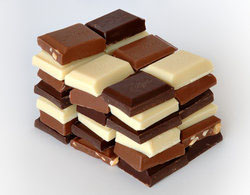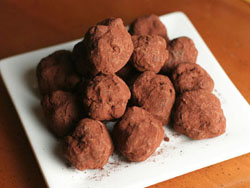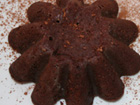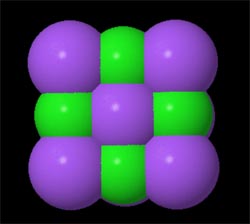All About Chocolate

Chocolate (see below for etymology) describes a number of raw and processed products that originate from the tropical cacao tree. It is a common ingredient in many kinds of sweets, and desserts. It is one of the most popular flavors in the world.
Chocolate is made from the fermented, roasted, and ground beans taken from the pod of the tropical cacao tree Theobroma cacao native to Central America, which has an intensely flavored bitter taste. The resulting products are known as "chocolate" or, in some parts of the world, cocoa.
The bean products are known under different names in different parts of the world. In the American chocolate industry:
- Cocoa is the solids of the cacao bean,
- Cocoa butter is the fat component, and
- Chocolate is a combination of the solids and the fat.
It is the solid and the fat combination, sweetened with sugar and other ingredients, that is made into chocolate bars and which is commonly referred to as chocolate by the public.
It can also be made into beverages (called cocoa and hot chocolate), and this was the original form used by the Aztecs, the Mayas, and the first European consumers.
Chocolate is often produced as small molded forms in the shape of animals, people, or inanimate objects to celebrate festivals worldwide. For example, molds of rabbits or eggs for Easter, coins or Saint Nicholas (Santa Claus) for Christmas, and hearts for Valentine's Day.
Types
Classification

Chocolate is an extremely popular ingredient, and it is available in many types. Different forms and flavors of chocolate are produced by varying the quantities of the different ingredients. Other flavors can be obtained by varying the time and temperature when roasting the beans.
- Unsweetened chocolate is pure chocolate liquor, also known as bitter or baking chocolate. It is unadulterated chocolate: the pure, ground roasted chocolate beans impart a strong, deep chocolate flavor. With the addition of sugar, however, it is used as the base for American-style layer cakes, brownies, confections, and cookies.
- Dark chocolate is chocolate without milk as an additive. It is sometimes called "plain chocolate". The U.S. Government calls this "sweet chocolate", and requires a 15% concentration of chocolate liquor. European rules specify a minimum of 35% cocoa solids.
- Milk chocolate is chocolate with milk powder or condensed milk added. The US Government requires a 10% concentration of chocolate liquor. EU regulations specify a minimum of 25% cocoa solids.
- Semisweet chocolate is often used for cooking purposes. It is a dark chocolate with high sugar content.
- Bittersweet chocolate is chocolate liquor (or unsweetened chocolate) to which sugar, more cocoa butter, lecithin, and vanilla has been added. It has less sugar and more liquor than semisweet chocolate, but the two are interchangeable in baking. The best quality bittersweet and semisweet chocolates are produced as couverture; many brands now print on the package the percentage of cocoa (as chocolate liquor and added cocoa butter) contained. The rule is that the higher the percentage of cocoa, the less sweet the chocolate will be.
- Couverture is a term used for chocolates rich in cocoa butter. Popular brands of couverture used by professional pastry chefs and often sold in gourmet and specialty food stores include: Valrhona, Felchlin, Cacao Barry, Callebaut, and Guittard. These chocolates contain a high percentage of cocoa (sometimes 70% or more) and have a total fat content of 36-40%.
- White chocolate is a confection based on cocoa butter without the cocoa solids.
- Cocoa powder. There are two types of unsweetened baking cocoa available: natural cocoa (like the sort produced by Hershey's and Nestlé) and Dutch-process cocoa (such as the Hershey's European Style Cocoa and the Droste brand). Both are made by pulverizing partially defatted chocolate liquor and removing nearly all the cocoa butter. Natural cocoa is light in color and somewhat acidic with a strong chocolate flavor. Natural cocoa is used in recipes which call for baking soda (because it is an alkali). Combining the two creates a leavening action that allows the batter to rise during baking. Dutch-process cocoa is processed with alkali to neutralize its natural acidity. Dutch cocoa is slightly milder in taste, with a deeper and warmer color than natural cocoa.
Flavors such as mint, orange and strawberry, are sometimes added to chocolate. A chocolate bar is a bar of chocolate, frequently containing added ingredients such as peanuts, rice and caramel.
Definition
Strictly speaking, chocolate is any product based 99% on cocoa solid and/or cocoa fat. Because it is used in a vast number of by-products, any change in the cost of making it has a huge impact on the industry. Adding ingredients is an aspect of the taste. On the other hand, reducing cocoa solid content, or substituting cocoa fat with a non-cocoa one, reduces the cost of making it. There has been disagreement in the EU about the definition of chocolate.
- Some want to see the definition allowing for any cocoa solid content and any kind of fat in chocolate. This would allow a merely colored and flavored margarine to be sold as being chocolate. In some countries this happens, and a 50% to 70% cocoa solid dark-chocolate, with no additive, for domestic use, is hard to find and expensive.
- Others believe in adhering more strictly to the definition above.
History
Etymology
The name chocolate most likely comes from the Nahuatl language indigenous to central Mexico, although it may have been influenced by the Mayan languages. One popular theory is that it comes from the Nahuatl word xocolatl , derived from xocolli, bitter, and atl, water. On the other hand, Mexican philologist Ignacio Davila Garibi proposed that "Spaniards had coined the word by taking the Maya word chocol and then replacing the Maya term for water, haa, with the Aztec one, atl." But this theory assumes that the conquistadores would change indigenous words from two very different languages, while at the same time adopting hundreds of other words from these same languages as-is, a highly unlikely scenario.
Origins
The chocolate residue found in a Mayan teapot suggests that Mayans were drinking chocolate 2,600 years ago, the earliest record of cacao use. The Aztecs associated chocolate with Xochiquetzal, the goddess of fertility. In the New World, chocolate was consumed in a bitter and spicy drink called xocoatl, often seasoned with vanilla, chile pepper, achiote (which we know today as annatto) and pimento. Xocoatl was believed to fight fatigue, a belief that is probably attributable to the theobromine content. Chocolate was an important luxury good throughout pre-Columbian Mesoamerica, and cocoa beans were often used as currency. Other chocolate drinks combined it with such edibles as maize gruel (which acts as an emulsifier) and honey.
The xocolatl was said to be an acquired taste. Jose de Acosta, a Spanish Jesuit missionary who lived in Peru and then Mexico in the later 16th century, wrote of it:
Loathsome to such as are not acquainted with it, having a scum or froth that is very unpleasant to taste. Yet it is a drink very much esteemed among the Indians, where with they feast noble men who pass through their country. The Spaniards, both men and women, that are accustomed to the country, are very greedy of this Chocolaté. They say they make diverse sorts of it, some hot, some cold, and some temperate, and put therein much of that "chili"; yea, they make paste thereof, the which they say is good for the stomach and against the catarrh.
Christopher Columbus brought some cocoa beans to show Ferdinand and Isabella of Spain, but it remained for Hernando de Soto to introduce it to Europe more broadly.
The first recorded shipment of chocolate to the Old World for commercial purposes was in a shipment from Veracruz to Seville in 1585. It was still served as a beverage, but the Europeans added sugar and milk to counteract the natural bitterness and removed the chilli pepper, replacing it with another Mexican indigenous spice, vanilla. Improvements to the taste meant that by the 17th century it was a luxury item among the European nobility.
At the end of the 18th century, the first solid chocolate we eat today was created in Turin. This chocolate was sold in large quantities from 1826 by Pierre Paul Caffarel. In 1819 F. L. Cailler opened the first Swiss chocolate factory. In 1828 Dutchman Conrad J. van Houten patented a method for extracting the fat from cocoa beans and making powdered cocoa and cocoa butter. Van Houten also developed the so-called Dutch process of treating chocolate with alkali to remove the bitter taste. This made it possible to form the modern chocolate bar. It is believed that the Englishman Joseph Fry made the first chocolate for eating in 1847, followed shortly after by the Cadbury brothers.
Daniel Peter, a Swiss candle maker, joined his father-in-law's chocolate business. In 1867 he began experimenting with milk as an ingredient. He brought his new product, milk chocolate, to market in 1875. He was assisted in removing the water content from the milk to prevent mildewing by a neighbor, a baby food manufacturer named Henri Nestle©. Rodolphe Lindt invented the process called conching, which involves heating and grinding the chocolate solids very finely to ensure that the liquid is evenly blended.
Physiological effects
Toxicity in animals
In sufficient amounts the theobromine found in chocolate is toxic to animals such as horses, dogs, parrots, and cats, because they are unable to metabolize the chemical effectively. If they are fed chocolate, the theobromine will remain in their blood for up to 20 hours, and these animals may experience epileptic seizures, heart attacks, internal bleeding, and eventually death. Medical treatment involves inducing vomiting within two hours of ingestion, or contacting a veterinarian.
A typical 20-kilogram dog will normally experience intestinal distress after eating less than 240 grams of milk chocolate, but will not necessarily experience bradycardia or tachycardia unless it eats at least a half a kilogram of milk chocolate. If it does not expel the chocolate from its system because of the fat and sugar content, then it would have a 50% chance of surviving after eating 5 kilograms. Dark, sweet chocolate has about 50% more theobromine and thus is more dangerous to dogs. According to the Merck Veterinary Manual, approximately 1.3 grams of baker's chocolate per kilogram of a dog's body weight (0.02 oz/lb) is sufficient to cause symptoms of toxicity. For example, a typical 25-gram baker's chocolate bar would be enough to bring about symptoms in a 20-kilogram dog.
Health benefits
Recent studies have shown that cocoa or dark chocolate has potent health benefits for people. Dark chocolate is full of the flavonoids epicatechin and gallic acid, which are antioxidants that help protect blood vessels, promote cardiac health, and prevent cancer. It also has been effectively demonstrated to counteract mild hypertension. In fact, dark chocolate has more flavonoids than any other antioxidant-rich food such as red wine, green and black tea, and blueberries. There has even been a fad diet named "Chocolate diet" that emphasis's eating chocolate and cocoa powder in capsules. However, consuming milk chocolate or white chocolate, or drinking milk with dark chocolate, appears to largely negate the health benefits. Chocolate is also a calorie-rich food with a high content of saturated fat, so daily intake of chocolate also requires reducing caloric intake of other foods.
Two-thirds of the fat in chocolate comes in the form of two saturated fats called stearic acid and oleic acid. However, unlike other saturated fats, these two do not raise levels of LDL cholesterol in the bloodstream. A 2001 study by researchers at Penn State University found that the flavonoids in chocolate slowed the oxidation of LDL cholesterol, a process that is believed to lead to atherosclerosis.
Medical applications
Mars, Incorporated, a Virginia-based candy company, spends millions of dollars each year on flavanol research. The company is in talks with pharmaceutical companies to license drugs based on synthesized cocoa flavanol molecules. According to Mars-funded researchers at Harvard, the University of California, and European universities, cocoa-based prescription drugs could potentially help treat diabetes, dementia and other diseases.
Mars is presently marketing the Cocoavia brand , a line of functional food chocolates which have cholesterol-reducing phytosterols and at least 100 milligrams of flavanols. The snacks are designed to be eaten primarily for heart benefits, and as such, Mars has recommended a regimen of two snacks per day.
Chocolate as a drug
Current research indicates that chocolate is a weak stimulant because of its content of theobromine. However, chocolate contains too little of this compound for a reasonable serving to create effects in humans that are on par with a coffee buzz. Aptly spoken by the pharmacologist Ryan J. Huxtable, "[Chocolate is] more than a food but less than a drug". However, chocolate is a very potent stimulant for dogs and horses; its use is therefore banned in horse-racing. Some chocolate products contain synthetic caffeine as an additive.
Chocolate also contains small quantities of the endogenous cannabinoid anandamide and the cannabinoid breakdown inhibitors N-oleoylethanolamine and N-linolenoylethanolamine. Anandamides are produced naturally by the body, in such a way that their effects are extremely targeted (compared to the broad systemic effects of drugs like tetrahydrocannabinol) and relatively short-lived. In experiments N-oleoylethanolamine and N-linolenoylethanolamine interfere with the body's natural mechanisms for breaking down endogenous cannabinoids, causing them to last longer. However, noticeable effects of chocolate related to this mechanism in humans have not yet been demonstrated.
Pleasure of consuming chocolate
Part of the pleasure of eating chocolate is ascribed to the fact that its melting point is slightly below human body temperature and, therefore, melts in the mouth. Chocolate also releases serotonin in the brain which produces feelings of pleasure in a similar way to sunlight. Although chemicals are released in certain areas of the brain, chocolate does not contain a significant amount of these chemicals so as to harm or affect human behavior.
Research has shown that heroin addicts tend to have an increased liking for chocolate because it triggers dopamine release in the brain an effect, albeit a legal one, similar to that of opium. See also: chocoholic.
Chocolate as an aphrodisiac
Romantic lore commonly identifies chocolate as an aphrodisiac. The reputed aphrodisiac qualities of chocolate are most often associated with the simple sensual pleasure of its consumption. More recently, suggestion has been made that serotonin and other chemicals found in chocolate, most notably phenethylamine, can act as mild sexual stimulants. While there is no firm proof that chocolate is indeed an aphrodisiac, giving a gift of chocolate to one's sweetheart is a familiar courtship ritual.
Lead
Chocolate has one of the highest concentrations of lead among all products that constitute a typical Westerner's diet. This is thought to happen because the cocoa beans are mostly grown in developing countries such as Nigeria. Those countries still use tetra-ethyl lead as a gasoline additive and, consequently, have high atmospheric concentrations of lead. According to the US Food and Drug Administration, levels of lead in chocolate are sufficiently low that even people who eat large amounts of chocolate every day are not at risk of any adverse effects. Some products have lower levels.
Production
There are three main varieties of cacao beans used in chocolates. "Criollo", the variety native to Central America, the Carribean islands and the northern tier of South American states, is the rarest and most expensive cocoa on the market. There is some dispute about the genetic purity of cocoas sold today as Criollo, since most populations have been exposed to the genetic influence of other varieties. Criollos are difficult to grow, as they are vulnerable to a host of environmental threats and deliver low yields of cocoa per tree. The flavor of Criollo is characterized as delicate but complex, low in classic "chocolate" flavor, but rich in "secondary" notes of long duration. Forastero is a large group of wild and cultivated cacaos, probably native to the Amazon basin. The huge African cocoa crop is entirely of the Forastero variety. They are significantly hardier and of higher yield than Criollo. Forastero cocoas are typically big in classic "chocolate" flavor, but this is of short duration and is unsupported by secondary flavors. There are exceptional Forasteros, such as the "Nacional" or "Arriba" variety which can posess great complexity. Trinitario, a natural hybrid of Criollo and Forastero, originated in Trinidad after an introduction of (Amelonado) Forastero to the local Criollo crop. These cocoas exhibit a wide range of flavor profiles according to the genetic heritage of each tree.
Nearly all cacao produced over the past five decades is of the Forastero or lower-grade Trinitario varieties. The share of higher quality Criollos and Trinitarios (so-called flavour cacao) is just under 5% per annum .
Harvesting
Firstly, the cacao pods, containing cacao beans, are harvested. The beans, together with their surrounding pulp, are removed from the pod and left in piles or bins to ferment for 3-7 days. The beans must then be quickly dried to prevent mold growth; climate permitting, this is done by spreading the beans out in the sun.
The beans are then roasted, graded and ground. Cocoa butter is removed from the resulting chocolate liquor either by being pressed or by the Broma process. The residue is what is known as cocoa powder.
Blending
Chocolate liquor is blended with the butter in varying quantities to make different types of chocolate or couverture. The basic blends of ingredients, in order of highest quantity of cocoa liquor first, are as follows. (Note that since American chocolates have a lower percentage requirement of cocoa liquor for dark chocolate, some dark chocolate may have sugar as the top ingredient.)
- Plain dark chocolate: sugar, cocoa butter, cocoa liquor, and (sometimes) vanilla
- Milk chocolate: sugar, cocoa butter, cocoa liquor, milk or milk powder, and vanilla
- White chocolate: sugar, cocoa butter, milk or milk powder, and vanilla
Usually, an emulsifying agent such as soya lecithin is added, though a few manufacturers prefer to exclude this ingredient for purity reasons and to remain GMO-free (Soya is a heavily genetically modified crop), sometimes at the cost of a perfectly smooth texture. Please note that the texture is also heavy influenced by processing, specifically conching. The more expensive chocolates tend to be processed longer and thus have a smoother texture and "feel" on the tongue, regardless of whether emulsifying agents are added.
Different manufacturers develop their own "signature" blends based on the above formulas but varying proportions of the different constituents used.
The finest plain dark chocolate couvertures contain at least 70% cocoa (solids + butter), whereas milk chocolate usually contains up to 50%. High-quality white chocolate couvertures contain only about 33% cocoa. Inferior and mass-produced chocolate contains much less cocoa (as low as 7% in many cases) and fats other than cocoa butter. Some chocolate makers opine that these "brand name" milk chocolate products can not be classed as couverture, or even as chocolate, because of the low or virtually non-existent cocoa content.
Conching
The penultimate process is called conching. A conche is a container filled with metal beads, which act as grinders. The refined and blended chocolate mass is kept liquid by frictional heat. The conching process produces cocoa and sugar particles smaller than the tongue can detect; hence the smooth feel in the mouth. The length of the conching process determines the final smoothness and quality of the chocolate. High-quality chocolate is conched for about 72 hours, lesser grades about four to six hours. After the process is complete, the chocolate mass is stored in tanks heated to approximately 45–50 °C (113-122 °F) until final processing.
Tempering
The final process is called tempering. Uncontrolled crystallization of cocoa butter typically results in crystals of varying size, some or all large enough to be clearly seen with the naked eye. This causes the surface of the chocolate to appear mottled and matte, and causes the chocolate to crumble rather than snap when broken. The uniform sheen and crisp bite of properly processed chocolate are the result of consistently small cocoa butter crystals produced by the tempering process. Additionally, since cocoa butter exhibits a polymorphous crystal formation, care must be taken during tempering to insure the formation of the most stable of the possible crystal forms, so that the appearance of the chocolate does not degrade over time. These goals are achieved by careful manipulation of temperature during the crystallization of the chocolate. Firstly, the mass is cooled from about 45 °C (113 °F) to about 27 °C (80 °F). Agitation during cooling precipitates the formation of large quantities of small crystal "seed" which will serve as nuclei for the final crystallization of the chocolate. The chocolate is then rewarmed to about 31 °C (88 °F) to eliminate unstable crystal forms and reduce the viscosity of the chocolate. The chocolate is then ready for use in molding or coating, after which it is allowed to cool.
Storing
Chocolate is very sensitive to temperature and humidity. Ideal storage temperatures are between 15 and 17 degrees Celsius (59 to 63 degrees Fahrenheit), with a relative humidity of less than 50%. Chocolate should be stored away from other foods as it can absorb different aromas. Ideally, chocolates are packed or wrapped and then placed in proper storage areas with the correct humidity and temperatures.
Chocolate and a vegan diet
It can be difficult to identify vegan chocolate. Milk chocolate does not qualify because of the added milk, but even chocolate labelled as "dark" may contain milk ingredients. For example, Hershey's Special Dark contains milk. Unless the chocolate is specifically labelled as vegan, another complication for strict vegans is that the sugar used in a particular chocolate may have been processed with bone char.
Endnotes
- Chocolate:Food of the Gods. Yale-New Haven Hospital.
- Effects of cocoa powder and dark chocolate on LDL oxidative susceptibility and prostaglandin concentrations in humans. Ying Wan, Joe A. Vinson, Terry D. Etherton, John Proch, Sheryl A. Lazarus and Penny M. Kris-Etherton, American Journal of Clinical Nutrition, Vol. 74, No. 5, 596–602, November 2001.
Further reading
- The True History of Chocolate, by Sophie D. Coe & Michael D. Coe, Thames & Hudson, 1996.
- Naked Chocolate, by David Wolfe and Shazzie, Rawcreation, 2005.
- The Great Book of Chocolate, by David Lebovitz, Ten Speed Press, 2004.
- The Chocolate Connoisseur, by Chloe Doutre-Roussel, Piatkus, 2005.
|
Science of Chocolate

What are the health benefits of Chocolate?
What are the drugs in Chocolate?
Research on Chocolate and Cocoa
Who makes the best Chocolate in the World?
Related Coffee Sites
See also:
Chemical compounds in coffee that produce aroma and bitterness
Science behind pulling the perfect espresso shot
Science of Cooking
See also:
